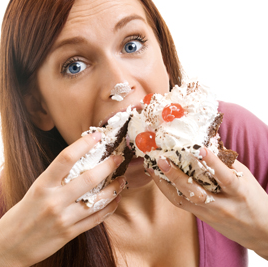16 May Emotional Eating…and HOW to Help It!
The Emotional Eating Roller Coaster
What’s your immediate reaction to personal or professional highs and lows? What do you do when you are stressed out, feel tired or anxious? Do you go running for the comfort foods? Even more important, do the words “I’ve had a crazy day so I DESERVE this…(ice cream/cookie/macaroni and cheese/wine/etc.)” come out of your mouth pretty frequently? Yup, just what I thought – you may be an emotional eater.
Defining emotional eating
 First and foremost, let’s define “emotional eating”. WebMD says emotional eating is about “eating to feed a feeling, and not a growling stomach.” I’d say that’s pretty accurate.
First and foremost, let’s define “emotional eating”. WebMD says emotional eating is about “eating to feed a feeling, and not a growling stomach.” I’d say that’s pretty accurate.
Basically it’s about responding to emotional cues, and not hunger cues, and developing an association between certain types of foods with specific emotions (happiness, sadness, feeling bored, etc.).
We all have our moments – the key is determining whether you eat more often due to emotion, or due to true hunger. If you have a hard time losing weight or maintaining a healthy weight, your answers may be just as much in WHEN or WHY you’re eating as well as WHAT you’re eating.
The food log as a help
The best way I have to analyze and determine eating cues is to add an extra column to a food log. In addition to writing down what foods are eaten during the day, the time of day should be noted along with how you’re feeling at the time (maybe even what you’re doing at the time, such as watching television or sitting at your desk at work).
As a result of including the additional information, you should start to see specific patterns develop. Maybe you’ll notice that you’re making good choices, and the only feeling you have at the time is hunger, or you might notice that you’re eating more often, straying from healthy options, and potentially spiraling into a greater depressed or anxious mood due to your own behaviors.
Some other clues that you may be an emotional eater are a need to have the desired food immediately, with no hesitation or thought involved (because it will supposedly SOLVE how you’re feeling), and an inability to stop eating, even when you may be full.
Once you know the WHY look at the WHAT
So after some brief food log analysis we’ve determined WHY you’re eating, now let’s discuss WHAT you’re eating.
The #1  emotional eating comfort food for both men and women is ice cream. Not a horrible option when eaten in moderation, right? Next on the list are chocolate, pizza, cookies, fast food (burgers and fries), and casseroles (macaroni and cheese).
emotional eating comfort food for both men and women is ice cream. Not a horrible option when eaten in moderation, right? Next on the list are chocolate, pizza, cookies, fast food (burgers and fries), and casseroles (macaroni and cheese).
If you’re typically a pretty healthy eater, it’s a big red flag when you’re craving junk food and actually fulfilling that desire on a regular basis. So if you look down and see a large spoon in your hand and an empty ice cream carton in your lap, you might want to consider addressing your feelings at the moment.
A great first step is removing yourself from the situation. Get outside and take a walk. Leave the house, leave the kitchen. If you’re at work, take a brief break. Whatever you have to do, start coping in a different way.
Do you have a friend or family member you can vent to? Do it! Call them! Do you feel better with journaling? Get out your pen and paper, go sit outside, and write your feelings down instead of feeding them! Do you like support groups? Join one – they are all over social media sites like for free.
You can’t fix irrational impulses with rational decisions.
What I’m telling you is that your emotional impulse to eat isn’t a rational one, so you can’t approach it with rational decision-making. You can’t necessarily talk yourself out of your desire for comfort. But you CAN change your surroundings and your stimulus.
Is a nutrition plan and accountability the solution?
 Another great option, especially if you’re aware that you are an emotional eater, is to keep yourself on a pretty strict nutrition plan while you work on addressing your emotional eating binges. This might help you keep your weight in check. Because we all know that when emotional eating leads to weight gain, it certainly leads to negative feelings and more emotional eating, and so forth.
Another great option, especially if you’re aware that you are an emotional eater, is to keep yourself on a pretty strict nutrition plan while you work on addressing your emotional eating binges. This might help you keep your weight in check. Because we all know that when emotional eating leads to weight gain, it certainly leads to negative feelings and more emotional eating, and so forth.
Along with physically removing yourself from the situation is funneling your feelings into something productive, such as exercise. Maybe you get yourself to a kick boxing class instead of having a snack? You may THINK you’re hungry, but once you’ve worked out your issues on the bag, you no longer feel that way.
Or throw some sneakers on and go running. Squash that stress with every foot step. Heck, if you’re still hungry when you’re covered in sweat and all is said and done, it really might be time for a healthy snack!
“Be Happy…Be Healthy…Be Fit!”
– Natalie Jill
Give me 7 days to teach you the habits that will change your life forever! Get your 7 Day Jump Start HERE.

